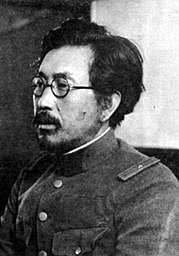| Revision as of 20:00, 30 November 2007 edit204.244.150.7 (talk)No edit summary← Previous edit | Revision as of 20:01, 30 November 2007 edit undo204.244.150.7 (talk)No edit summaryNext edit → | ||
| Line 6: | Line 6: | ||
| |image=] | |image=] | ||
| |caption=General Shirō Ishii | |caption=General Shirō Ishii | ||
| |nickname= |
|nickname= | ||
| |allegiance=] | |allegiance=] | ||
| |branch=] ] | |branch=] ] | ||
Revision as of 20:01, 30 November 2007
| Shirō Ishii | |
|---|---|
 General Shirō Ishii General Shirō Ishii | |
| Allegiance | Empire of Japan |
| Service | |
| Years of service | 1921 -1945 |
| Rank | Lieutenant General |
| Commands | Unit 731, Kwantung Army |
| Battles / wars | Second Sino-Japanese War World War II |
Template:Japanese name Shirō Ishii (石井四郎, Ishii Shirō, 25 June 1892 – 9 October 1959) was a microbiologist and the lieutenant general of Unit 731, a biological warfare unit of the Imperial Japanese Army during the Second Sino-Japanese War.
Biography
Ishii was born in the former Shibayama Village of Sanbu District in Chiba Prefecture, and studied medicine at Kyoto Imperial University. Although he was considered a selfish, pushy, and sometimes disturbed individual, he excelled in his studies, and in 1922 was assigned to the 1st Army Hospital and Army Medical School in Tokyo. There his work impressed his superiors enough to gain him, two years later, post-graduate medical schooling back at the Kyoto Imperial University.
Beginning in 1928, Ishii took a two-year tour of the West. In his travels, he did extensive research on the effects of biological warfare and chemical warfare developments from World War I onwards. It was a highly successful mission and helped win him the patronage of Sadao Araki, Minister of the Army.
In 1932, he began his preliminary experiments in biological warfare as a secret project for the Japanese military. In 1936, Unit 731 was formed. Ishii built a huge compound -- more than 150 buildings over six square kilometers -- outside the city of Harbin, China. The research was secret, and the cover story was that Unit 731 was engaged in water-purification work.
From 1940, Ishii was appointed Chief of the Biological Warfare Section of the Kwangtung Army, holding the post simultaneously with that of the Bacteriological Department of the Army Medical Academy.
In 1942, Ishii began field tests of germ warfare agents developed, and various methods of dispersion (i.e. via firearms, bombs etc.) both on Chinese prisoners of war and operationally on battlefields and against civilians in Chinese cities. Some historians estimate that tens of thousands died as a result of the bio-weapons (including bubonic plague, cholera, anthrax and others) deployed. His unit also conducted physiological experiments on human subjects, including vivisections, forced abortions, and simulated strokes and heart attacks.
From 1942-1945, Ishii was Chief of the Medical Section of the Japanese First Army
In 1945, in the final days of the Pacific War and in the face of imminent defeat, Japanese troops blew up the headquarters of Unit 731 in order to destroy evidence of the research done there. As part of the cover-up, Ishii ordered 150 remaining subjects killed. Between 3,000 and 10,000 test subjects , which Ishii and his peers called maruta (丸太; "logs," a reference to their view of subjects being inert, expendable entities) eventually died at the hands of Unit 731.
Arrested by the American occupation authorities at the end of World War II, Ishii and Unit 731 leaders received immunity in 1946 from war-crimes prosecution in exchange for germ warfare data based on human experimentation. The deal was concluded two years later.
Ishii was never prosecuted of any war crimes, and died of throat cancer at the age of 67.
See also
References
Books
- Barenblatt, Daniel. A Plague Upon Humanity: the Secret Genocide of Axis Japan's Germ Warfare Operation, HarperCollins, 2004. ISBN 0-06-018625-9
- Gold, Hal. Unit 731 Testimony, Charles E Tuttle Co., 1996. ISBN 4-900737-39-9
- Williams, Peter. Unit 731: Japan's Secret Biological Warfare in World War II, Free Press, 1989. ISBN 0-02-935301-7
- Harris, Sheldon H. Factories of Death: Japanese Biological Warfare 1932-45 and the American Cover-Up, Routledge, 1994. ISBN 0-415-09105-5 ISBN 0-415-93214-9
- Endicott, Stephen and Hagerman, Edward. The United States and Biological Warfare: Secrets from the Early Cold War and Korea, Indiana University Press, 1999. ISBN 0-253-33472-1
- Handelman, Stephen and Alibek, Ken. Biohazard: The Chilling True Story of the Largest Covert Biological Weapons Program in the World--Told from Inside by the Man Who Ran It, Random House, 1999. ISBN 0-375-50231-9 ISBN 0-385-33496-6
- Harris, Robert and Paxman, Jeremy. A Higher Form of Killing : The Secret History of Chemical and Biological Warfare, Random House, 2002. ISBN 0-8129-6653-8
- Barnaby, Wendy. The Plague Makers: The Secret World of Biological Warfare, Frog Ltd, 1999. ISBN 1-883319-85-4 ISBN 0-7567-5698-7 ISBN 0-8264-1258-0 ISBN 0-8264-1415-X
External links
- Ammenthorp, Steen. "Ishii, Shiro". The Generals of World War II.
- Unit 731. 2001-01-21.
- Deep Black Lies: Unit 731. No date.
- Germ warfare. No date.
- Shiro Ishii. Doctors of Depravity
Notes
- Ammenthorp, The Generals of World War II
- Ammenthorp, The Generals of World War II
- "http://www.commondreams.org/views05/0510-24.htm An Ethical Blank Cheque: British and US mythology about the second world war ignores our own crimes and legitimises Anglo-American war making- the Guardian, May 10, 2005, by Richard Drayton
- Doctors of Depravity